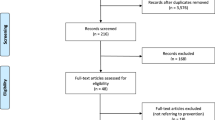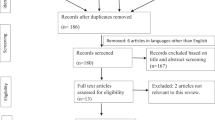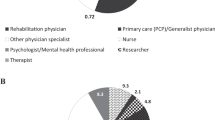Abstract
Study design
Pre–post intervention.
Objectives
-
1.
To test whether replacement of oral anticholinergic (AC) agents with mirabegron for neurogenic lower urinary tract dysfunction (NLUTD) yields improved cognitive function in older persons with spinal cord injury (SCI).
-
2.
To test whether mirabegron is safe and as efficacious as AC.
Setting
USA.
Methods
Pilot study: Twenty older (>60 y/o) persons with SCI taking chronic (>6 months) AC medication for NLUTD were enrolled. All participants were first studied on AC at baseline then switched to mirabegron for 6 months. Primary outcomes were cognitive tests of (1) executive function (TEXAS, SDMT); (2) attention (SCWT); and (3) memory (SLUMS and WMS-IV Story A/B). Secondary outcomes assessed efficacy and safety including Neurogenic Bladder Symptom Score (NBSS), bladder diary, neurogenic bowel dysfunction (NBD) survey, heart rate (HR), electrocardiogram (EKG), and mean arterial pressure (MAP).
Results
When switching from AC to mirabegron for NLUTD, older persons with SCI exhibited statistically significant improvements in immediate Story A recall (p = 0.01), delayed story A and B recall (p = 0.01, 0.004), and in TEXAS (p = 0.04). Three subscores within NBSS significantly improved (p = 0.001) and the frequency of incontinence decreased (p = 0.03) on mirabegron. NBD, HR, MAP, and EKGs were unchanged.
Conclusions
Older persons with SCI on AC for NLUTD demonstrated improved short-term and delayed memory (WMS-IV Story A/B) as well as executive function (TEXAS) when switched to mirabegron. Efficacy of mirabegron for NLUTD symptoms was superior to AC with no adverse effects on bowel or cardiovascular function.
Sponsorship
Claude D. Pepper Older Americans Independence Center.
Similar content being viewed by others
Log in or create a free account to read this content
Gain free access to this article, as well as selected content from this journal and more on nature.com
or
References
National Spinal Cord Injury Statistical Center. Facts and figures at a glance. Birmingham, AL: National Spinal Cord Injury Statistical Center; 2017. Accessed.
Ku JH. The management of neurogenic bladder and quality of life in spinal cord injury. BJU Int. 2006;98:739–45.
Stover SL. Review of forty years of rehabilitation issues in spinal cord injury. J Spinal Cord Med. 1995;18:175–82.
Bowie MW, Slattum PW. Pharmacodynamics in older adults: a review. Am J Geriatr Pharmacother. 2007;5:263–303.
Montagne A, Barnes SR, Sweeney MD, Halliday MR, Sagare AP, Zhao Z, et al. Blood–brain barrier breakdown in the aging human hippocampus. Neuron 2015;85:296–302.
van Assema DM, Lubberink M, Boellaard R, Schuit RC, Windhorst AD, Scheltens P, et al. P-glycoprotein function at the blood–brain barrier: effects of age and gender. Mol Imaging Biol. 2012;14:771–6.
Perry EK, Kilford L, Lees AJ, Burn DJ, Perry RH. Increased Alzheimer pathology in Parkinson’s disease related to antimuscarinic drugs. Ann Neurol. 2003;54:235–8.
Gray SL, Anderson ML, Hanlon JT, Dublin S, Walker RL, Hubbard RA, et al. Exposure to strong anticholinergic medications and dementia-related neuropathology in a community-based autopsy cohort. J Alzheimers Dis. 2018;65:607–16.
Risacher SL, McDonald BC, Tallman EF, West JD, Farlow MR, Unverzagt FW, et al. Association between anticholinergic medication use and cognition, brain metabolism, and brain atrophy in cognitively normal older adults. JAMA Neurol. 2016;73:721–32.
Gray SL, Hanlon JT. Anticholinergic medication use and dementia: latest evidence and clinical implications. Ther Adv Drug Saf. 2016;7:217–24.
By the American Geriatrics Society Beers Criteria Update Expert P. American Geriatrics Society. 2015 Updated beers criteria for potentially inappropriate medication use in older adults. J Am Geriatr Soc. 2015;63:2227–46.
Gormley EA, Lightner DJ, Faraday M, Vasavada SP.American Urological A, Society of Urodynamics FPM Diagnosis and treatment of overactive bladder (non-neurogenic) in adults: AUA/SUFU guideline amendment. J Urol. 2015;193:1572–80.
Welk B. Mirabegron: a decade of study. Transl Androl Urol. 2020;9:2286–8.
Welk B, Hickling D, McKibbon M, Radomski S, Ethans K. A pilot randomized-controlled trial of the urodynamic efficacy of mirabegron for patients with neurogenic lower urinary tract dysfunction. Neurourol Urodyn. 2018;37:2810–7.
Wollner J, Pannek J. Initial experience with the treatment of neurogenic detrusor overactivity with a new beta-3 agonist (mirabegron) in patients with spinal cord injury. Spinal Cord. 2016;54:78–82.
Wada N, Okazaki S, Kobayashi S, Hashizume K, Kita M, Matsumoto S, et al. [Efficacy of combination therapy with mirabegron for anticholinergic-resistant neurogenic bladder: videourodynamic evaluation]. Hinyokika Kiyo. 2015;61:7–11.
Kamei J, Furuta A, Akiyama Y, Niimi A, Ichihara K, Fujimura T, et al. Video-urodynamic effects of mirabegron, a beta3-adrenoceptor agonist, in patients with low-compliance bladder. Int J Urol. 2015;22:956–61.
Drozdick LW, Holdnack JA, Salthouse T, Cullum CM. Assessing cognition in older adults with the WAIS-IV, WMS-IV, and ACS. In: WAIS-IV, WMS-IV, and ACS: Advanced clinical interpretation. San Diego, CA, USA: Elsevier Academic Press; 2013, p. 407–83. https://doi.org/10.1016/B978-0-12-386934-0.00009-2.
Szczesniak D, Rymaszewska J. The usfulness of the SLUMS test for diagnosis of mild cognitive impairment and dementia. Psychiatr Pol. 2016;50:457–72.
Salazar R, Velez CE, Royall DR. Telephone screening for mild cognitive impairment in hispanics using the Alzheimer’s questionnaire. Exp Aging Res. 2014;40:129–39.
Smith A. Symbol digit modalities test: manual. Los Angeles, CA, USA: Western Psychological Services; 1982.
Golden C, Stroop S. Color word test. Chicago: Stoelting Co.; 1978.
Lee J, Dudley-Javoroski S, Shields RK. Motor demands of cognitive testing may artificially reduce executive function scores in individuals with spinal cord injury. J Spinal Cord Med. 2021;44:253–61.https://doi.org/10.1080/10790268.2019.1597482.
Welk B, Morrow S, Madarasz W, Baverstock R, Macnab J, Sequeira K. The validity and reliability of the Neurogenic Bladder Symptom Score. J Urol. 2014;192:452–7.
Welk B, Lenherr S, Elliott S, Stoffel J, Presson A, Zhang C, et al. The Neurogenic Bladder Symptom Score (NBSS): a secondary assessment of its validity, reliability among people with a spinal cord injury. Spinal Cord. 2018;56:259–64.
Schemann M, Hafsi N, Michel K, Kober O, Wollmann J, Li Q, et al. The beta3-adrenoceptor agonist GW427353 (Solabegron) decreases excitability of human enteric neurons via release of somatostatin. Gastroenterology 2010;138:266–74.
Cameron AP, Rodriguez GM, Gursky A, He C, Clemens JQ, Stoffel JT. The severity of bowel dysfunction in patients with neurogenic bladder. J Urol. 2015;194:1336–41.
Craig A, Guest R, Tran Y, Middleton J. Cognitive impairment and mood states after spinal cord injury. J Neurotrauma. 2017;34:1156–63.
Chiaravalloti ND, Weber E, Wylie G, Dyson-Hudson T, Wecht JM. Patterns of cognitive deficits in persons with spinal cord injury as compared with both age-matched and older individuals without spinal cord injury. J Spinal Cord Med. 2020;43:88–97.
Cruz-Oliver DM, Malmstrom TK, Roegner M, Tumosa N, Grossberg GT. Cognitive deficit reversal as shown by changes in the Veterans Affairs Saint Louis University Mental Status (SLUMS) examination scores 7.5 years later. J Am Med Dir Assoc. 2014;15:687e685–610.
Tombaugh TN. Test–retest reliable coefficients and 5-year change scores for the MMSE and 3MS. Arch Clin Neuropsychol. 2005;20:485–503.
Royall DR, Mahurin RK, Gray KF. Bedside assessment of executive cognitive impairment: the executive interview. J Am Geriatr Soc. 1992;40:1221–6.
Kiely KM, Butterworth P, Watson N, Wooden M. The Symbol Digit Modalities Test: normative data from a large nationally representative sample of Australians. Arch Clin Neuropsychol. 2014;29:767–75.
Anderson KD. Targeting recovery: priorities of the spinal cord-injured population. J Neurotrauma. 2004;21:1371–83.
Acknowledgements
This material is the result of work supported with resources and the use of facilities at the Audie L. Murphy Veteran’s Affairs Hospital in San Antonio, TX.
Funding
Funding is provided by Claude D. Pepper Older Americans Idependence Center.
Author information
Authors and Affiliations
Corresponding author
Ethics declarations
Conflict of interest
While SK (author) does acknowledge conflict of interest with the manufacturer of Mirabegron (Astellas), he did not have access to data from the study that could have potentially created bias in results.
Additional information
Publisher’s note Springer Nature remains neutral with regard to jurisdictional claims in published maps and institutional affiliations.
Rights and permissions
About this article
Cite this article
Trbovich, M., Romo, T., Polk, M. et al. The treatment of neurogenic lower urinary tract dysfunction in persons with spinal cord injury: An open label, pilot study of anticholinergic agent vs. mirabegron to evaluate cognitive impact and efficacy. Spinal Cord Ser Cases 7, 50 (2021). https://doi.org/10.1038/s41394-021-00413-6
Received:
Revised:
Accepted:
Published:
DOI: https://doi.org/10.1038/s41394-021-00413-6
This article is cited by
-
Impact of Neurogenic Lower Urinary Tract Dysfunction on Bowel Symptoms
Current Bladder Dysfunction Reports (2023)
-
Efficacy and safety of mirabegron for treatment of neurogenic detrusor overactivity in adults with spinal cord injury or multiple sclerosis: a systematic review
Spinal Cord (2022)
-
Urological Care After Spinal Cord Injury
Current Physical Medicine and Rehabilitation Reports (2022)



